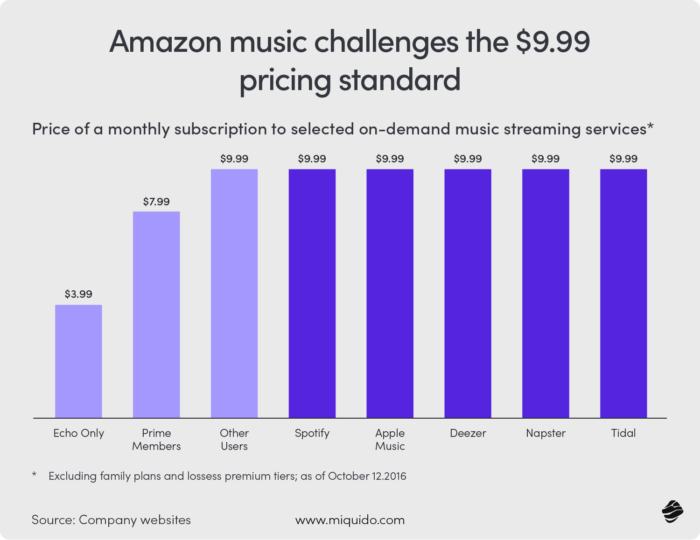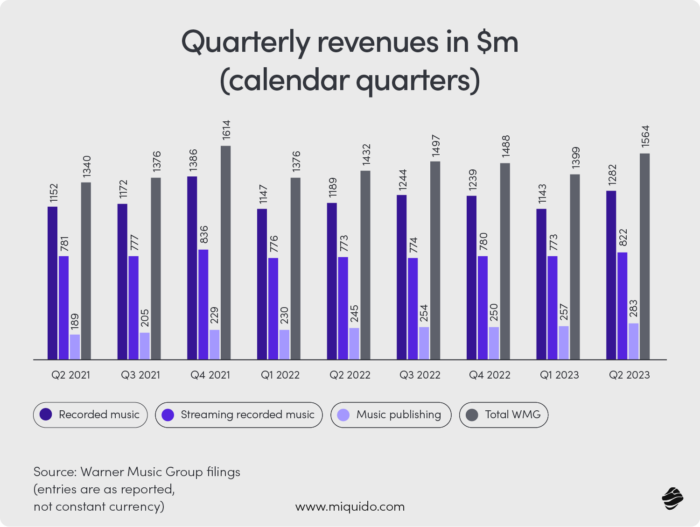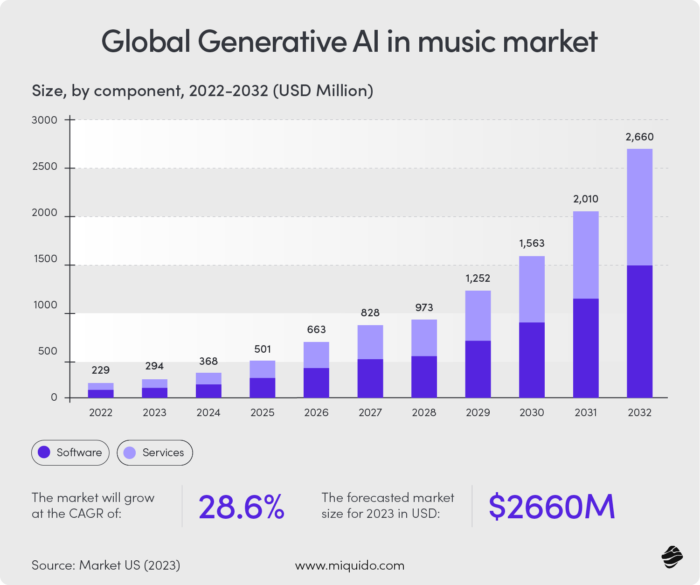Although it’s already well-established, the music streaming industry still faces significant challenges as it strives to maintain growth and profitability.
The market is becoming increasingly saturated and competitive. Both consumers and artists no longer have to choose the most well-known streaming platforms; they can easily find alternative services tailored to their needs, musical preferences, and financial capabilities.
The streaming services best positioned for success in the near future are likely those with the financial backing, scale, and diversity to adapt to the industry’s evolving demands. Additionally, profitably delivering services, rather than solely focusing on market share, has become essential as the industry matures, signaling a new phase of market development.
Navigating this complex landscape often requires specialized knowledge and expertise. Many companies turn to music application development services to ensure their platform stands out in a crowded market. These services provide tailored solutions that address both the technical and user-experience challenges unique to music streaming.
In this article, we will explore the various streaming music industry challenges and discuss potential strategies for overcoming them. From profitability issues to raising subscription rates, let’s dive into the key challenges in the music industry.
P.S. For those considering entering this competitive field, understanding how to create a music streaming app is crucial. Read our guide to ensure your music streaming application stands out!
Profitability and raising subscription rates are key streaming music industry challenges
One of the significant streaming music industry challenges is the rising costs associated with licensing agreements, which raises concerns about the long-term sustainability of current business models.
Industry experts like Robert Kyncl, CEO of Warner Music Group, insist that the recent subscription plan price increases across major music streaming platforms, including Amazon and Spotify, will become a recurring trend (Szalai, 2023).
The streaming market, offering consumers high-quality services at an accessible price, can bear further price hikes. Therefore, a key challenge in the music industry will soon be balancing these increases with maintaining the quality and value of the music catalog.

Kyncl’s viewpoint on the necessity of regular streaming price hikes is influenced by his experience negotiating music rights at YouTube, from the relatively stagnant subscription prices of services like Spotify to the escalating prices of other entertainment platforms like Netflix.
Despite his advocacy for incremental price hikes, Kyncl clarified that the approach should not lead to abrupt jumps in subscription costs.
WMG’s recent earnings report highlighted revenue growth, particularly in streaming, which increased by 7.3% YoY to $822 million. Kyncl’s strategic focus on price optimization and innovation, particularly concerning AI-generated music and monetising superfans, indicates a shifting landscape for the music streaming industry as it matures and seeks new avenues of revenue growth.

However, even the giants in the streaming industry had to finally give in and increase the subscription fee due to the cost pressure. According to the latest report on the music streaming sector, “the pressures (on profit growth) ultimately forced the undisputed market leader, Spotify, to increase its prices in the U.S. in July 2023 for the first time in over a decade” (Chung, 2023).
Spotify managed to hold out far longer than its rivals, including Apple Music, Tidal and YouTube Music, which have steadily increased prices over the past couple of years.
The costs associated with licensing music, developing and maintaining platforms, and marketing can be challenging for some services to turn a profit. What will be the next moves of other major players in the highly competitive and saturated music streaming industry remains to be seen.
Subscription fatigue
Consumers gradually become overwhelmed or disenchanted with the increasing number of subscription services available on the market. As the music streaming landscape evolves, users face numerous options, contributing to subscription fatigue.
However, the abundance of choices is not the only factor contributing to the fatigue phenomenon. With the proliferation of streaming services, content is becoming increasingly fragmented.
Different providers offer exclusive recordings, live concerts or remixes, leading to the emergence of subscription fatigue as consumers must choose between multiple platforms to access their favorite content. The pressure to acquire and produce exclusive material has led to a mixed bag of content, with some platforms sacrificing quality for cheaper, churnable content.
As a result, consumers may find it overwhelming to manage multiple subscriptions. A growing subset of users indicates they’re tired of numerous subscriptions and experiencing an overload. Apparently, despite the appetite for new content, consumers don’t need or want to use more sources of entertainment than the ones they’re already benefiting from.
User acquisition and retention
User acquisition for music streaming services became extremely challenging due to the intensely competitive nature of the industry. With major players and new entrants vying for subscribers, distinguishing one service from another in a crowded market becomes a hurdle. Acquiring new users often comes with hefty marketing costs as platforms engage in advertising campaigns, partnerships, and exclusive content deals to capture attention.
The strategic use of free, ad-supported tiers is a common tactic to attract users, but the real challenges in the music industry lie in converting these users into premium, paid subscribers. This requires sophisticated marketing and communication strategies to convey the added value of premium features. Meanwhile, global expansion poses another layer of complexity, demanding an in-depth understanding of diverse cultural preferences, licensing intricacies, and regional market dynamics.
Another side of the coin is the user retention, which requires a holistic approach. First and foremost, maintaining a diverse and high-quality content library is imperative for keeping users engaged and preventing them from seeking alternatives. The next challenging matter concerns the effectiveness of personalisation algorithms, as they enhance the user experience by providing accurate recommendations.
A seamless and user-friendly interface contributes to a positive experience; meanwhile, any complications, glitches, or slow performance can be a deterrent. Competitive pricing is also critical, as users may be inclined to switch to a different platform if they perceive better value elsewhere. Promotional offers and loyalty programs can be effective strategies to incentivise users to remain subscribed over the long term.
Bogusław Podhalicz
Design Team Leader at Miquido
Embracing AI & Machine Learning can solve many streaming music industry challenges
In the modern world of music production, AI is no longer a futuristic concept; it’s a present reality. Therefore, embracing its full potential is now one of the key streaming music industry challenges.
According to the 2023 survey run by Ditto Music, a staggering 60% of musicians already harness AI for various aspects of music production, including mastering, generating artwork, and even composing (Ditto, 2023).
The AI music market’s value, standing at $294 million in 2023, is a clear indicator of this burgeoning trend. This market is skyrocketing, with projections placing its valuation at a massive $2.6 billion by 2032.

The real streaming music industry challenges now are to ensure that AI’s role in music goes beyond mere assistance. Algorithms are now capable of generating original compositions that bear a striking resemblance to existing hits. As this technology continues to evolve, we can expect an influx of AI-generated music, blurring the lines between human creativity and machine intelligence.
But AI’s influence isn’t confined to creation alone. The realms of prediction and analytics are also under its spell. Machine learning, for instance, has achieved a remarkable feat in hit song prediction, boasting a 97% accuracy rate by analyzing neural data collected from listeners (Pirchner, 2023).
This level of precision opens new doors for understanding audience preferences and revolutionizes how the music industry approaches production and marketing.
Personalized music recommendations
AI-driven personalisation in music streaming is like having a personal DJ who knows your taste inside out. By analyzing your listening history, preferences, genres you lean towards, and even the time of day you listen, AI creates a bespoke playlist that feels intuitively aligned with your mood and preferences.
It’s not just about song suggestions of artists listened to before; it’s about discovering new music that resonates with particular tastes. This level of personalisation keeps the streaming experience fresh, engaging, and deeply satisfying.
The secret sauce to AI’s success in personalizing music lies in its sophisticated algorithms. These algorithms sift through massive datasets, identifying patterns and correlations in user behavior.
They consider various factors, including the songs played often, skipped, added to playlists, and even the total time spent listening to a particular track. By continuously learning and adapting to evolving tastes, these algorithms ensure that the music recommendation remains dynamic and relevant.
AI’s impact goes beyond curating playlists. It’s about creating a connection between the listener and music. For instance, discovering a new artist or genre matching listeners’ preferences through a recommendation deepens the user’s trust in the platform.
Many streaming music industry challenges can be solved by embracing AI. Such experiences enhance user satisfaction and foster a sense of discovery and willingness to explore within the app. It’s like having a music expert who knows both the vast world of music and your personal preferences, bridging the gap between the two.
AI-driven music generation and composition
Undoubtedly, the emergence of AI in music creation and composition is transforming the creative process and solving many streaming music industry challenges. However, I don’t believe that artificial intelligence will replace musicians anytime soon. My safe bet is that AI will eliminate repetitive and generic tasks, accelerating and enhancing the work of musicians instead of eliminating jobs.
AI-driven tools and platforms such as Amper Music, Aiva, and Udio can create melodies, harmonies, and even entire compositions. These AI systems learn and mimic various musical styles by analyzing vast databases of existing music, providing a new tool for both professional musicians and hobbyists.
But is there an AI that can create something truly groundbreaking in music? I’m not talking about revolutionary, civilization-changing breakthroughs like the transition from single melodic lines to polyphony that occurred in the Middle Ages or the invention of electronic music. I mean music that deeply moves us, taking us to imaginary worlds through a conscious, artistic reinterpretation of motifs already present in culture. Like the iconic Howard Shore’s soundtrack to Lord of the Rings or Pink Floyd’s Animals album.
At the moment, AI is most impactful in generating background music for games, films, and commercials that require specific moods or styles. I will repeat it: it can speed up and enhance artists’ work. However, at this stage of technology development, it will not create a real work of art. To paraphrase a quote from one of my favorite movies, Dead Poets Society, we listen to and compose music because we are members of the human race, and the human race is full of passion. Passion is the special element that makes humans excel over AI in all creative endeavors.
Jerzy Biernacki
Chief AI Officer at Miquido
Accessibility and inclusivity
One of the key streaming music industry challenges is accessibility. AI-driven music generation has made the creative process more accessible to individuals with varying levels of musical expertise. With the provision of tools and platforms for music creation that require minimal technical skills, AI empowers a broader spectrum of people to participate in artistic expression.
This inclusivity fosters diversity in musical styles, perspectives, and voices, enriching the creative landscape with fresh ideas and unique contributions.
Expanding creative horizons
AI in music composition is also breaking down streaming music industry challenges in creativity. It allows musicians to experiment with styles and genres outside of their expertise, fostering cross-genre innovation and experimentation. For a jazz musician exploring electronic music or a classical composer delving into hip-hop beats, AI makes these forays more accessible and feasible.
AI algorithms can analyze large amounts of data and recognise intricate patterns, which enables artists to explore new possibilities, innovate, and move beyond the conventions of established genres and styles. The AI-powered horizon expansion may result in the emergence of fresh sounds, aesthetics, and artistic movements.
Streaming music industry challenges related to AI-based homogenisation and commercialisation
AI-driven music generation has the potential to bring about various benefits. However, it also raises concerns about the commodification of music. There is a risk of homogenisation and commercialisation as algorithms prioritize popular trends and formulas based on user data.
This focus on commercial success may lead to music becoming formulaic and generic, resulting in a loss of originality, diversity, and cultural richness. Moreover, independent artists and niche genres may end up marginalized due to the progressing commodification of creativity.
While Generative AI in music industry opens up new creative avenues, it also raises questions about authenticity and the role of technology in art. Therefore, it is necessary to carefully determine the ownership and rights over AI-generated compositions and establish ethical guidelines for their use and distribution. It is crucial for ensuring fair compensation, recognition, and protection for both human creators and AI systems.
Julia Matuszewska
AI Marketing & Business Growth Consultant
Miquido
Enhanced audio quality and restoration via AI
As the demand for high-quality audio experiences increases, AI-driven solutions address streaming music industry challenges such as noise reduction, audio restoration, and quality enhancement. AI is advancing audio quality and preserving the legacy of music recordings.
AI algorithms can analyze and repair imperfections in old recordings, such as removing background noise, hisses, and pops.
This restoration process rejuvenates vintage tracks, making them clearer and more enjoyable for modern listeners. It’s like giving a new lease of life to historical recordings, ensuring they resonate with future generations.
Beyond restoration, AI is being used to enhance the overall audio quality of music tracks. It includes optimizing sound for different playback environments, from headphones to large speaker systems, ensuring listeners get the best possible experience regardless of their listening setup. By adapting to the nuances of different audio systems, AI ensures that every note, beat, and melody is heard as intended.
Spatial Computing
Spatial computing is revolutionizing the way we interact with technology, blending digital elements seamlessly into the physical world. With the aid of goggles or glasses, users can manipulate digital content with simple hand gestures, moving beyond the confines of traditional screens to a more intuitive and immersive experience.
But does this visually-driven technology have a place in the music industry, particularly in music streaming? To find out, we spoke with Maciej Szwed, the Head of Innovation at Miquido.
Spatial computing is transforming the music industry in exciting ways, and the Apple Vision Pro headset is a standout example of this fascinating technology at work. Moving beyond the conventional bounds of augmented reality, which typically emphasizes visuals, the Apple Vision Pro steps up with advanced audio features that revolve around spatial audio. This technology envelops the listener in a captivating sound environment, giving the impression that sounds emanate from all around them.
The key feature is Spatial Audio, which immerses listeners in rich soundscapes and accurately positions them in a 360-degree auditory environment.

The Apple Vision Pro enhances the listening experience with dynamic head tracking. This adjusts the audio as you turn your head, heightening the realism of sounds. It’s particularly impressive when the sound source in your virtual environment moves in sync with you, maintaining precise directionality and a sense of spatial consistency.
The headset also utilizes audio ray tracing to dynamically map the acoustics of your surroundings, optimizing audio delivery for the most lifelike experience possible.
These pioneering audio features are integrated with crystal-clear displays and an array of sensors, positioning the Apple Vision Pro as a top-tier device for both visual and auditory immersion. Compatibility with AirPods Pro (2nd generation) guarantees that users can enjoy superior, ultra-responsive sound, enhancing every aspect of the multimedia experience.
With its focus on spatial audio coupled with cutting-edge technology, the Apple Vision Pro sets a new benchmark for immersive audiovisual technology in wearable devices. It’s perfectly suited for a wide range of uses, from music streaming and entertainment to professional collaboration, making it a thrilling option for those looking to elevate their auditory and visual experiences.

Is spatial computing the right choice for your brand?
Before diving into spatial computing, consider your target audience, both for your product and for the technology itself. Although still in its early days, the spatial computing market is growing, with over 200,000 devices sold despite a hefty price tag of $3,500.
Spatial computing offers a fantastic opportunity for companies dedicated to delivering premium, exclusive user experiences. It also provides a chance for innovation and market differentiation. With the technology not yet widely adopted, now is the perfect time to explore this intriguing market niche. There’s an increasing demand for music and streaming applications, as well as features that enhance the utility of these devices.
Is spatial computing worth a try in your case? It could be, but I would need to learn more about you first. You can always reach out to us for a free consultation.
Streaming music industry challenges: in closing
One of the biggest challenges in the music industry is making sure that price increases for subscriptions are balanced with high-quality content. As licensing costs go up, streaming services need to justify these price hikes without losing the trust of their users. This is essential for maintaining a loyal customer base in a crowded market.
Artificial Intelligence and machine learning are becoming vital tools for solving many music industry challenges. These technologies can enhance user experience by providing personalized music recommendations and improving the overall efficiency of streaming services. However, it’s important to handle the ethical issues and potential over-commercialization that come with AI in music.
Engaging and Retaining Subscribers
Another key challenge in the music industry is keeping subscribers engaged. To do this, streaming services must offer a seamless and enjoyable user experience. This includes having a large and diverse music library, using advanced algorithms for personalized suggestions, and maintaining competitive pricing. Additionally, user-friendly interfaces and loyalty programs can help retain subscribers.
Embracing New Technologies
New technologies like spatial computing are also opening up exciting possibilities for the streaming music industry. These innovations offer immersive audio experiences that can set streaming services apart in a competitive market. Companies that invest in these technologies early will likely have an edge.
In summary, while there are many challenges in the streaming music industry, there are also great opportunities for those who innovate and adapt. By focusing on user needs and leveraging new technologies, including generative AI in music creation, streaming services can overcome these challenges and continue to grow. Collaborating with a Generative AI development company can provide the necessary expertise and tools to harness these advancements effectively.
As the industry evolves, the companies that successfully navigate these challenges will lead the way in creating better and more immersive music experiences for listeners around the world.








